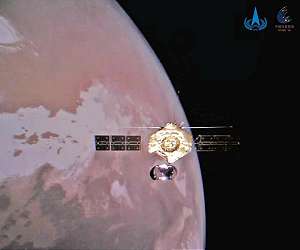New Curtin University research has confirmed the frequency of asteroid collisions that formed impact craters on Mars has been consistent over the past 600 million years.
The study, published in Earth and Planetary Science Letters, analysed the formation of more than 500 large Martian craters using a crater detection algorithm previously developed at Curtin, which automatically counts the visible impact craters from a high-resolution image.
Despite previous studies suggesting spikes in the frequency of asteroid collisions, lead researcher Dr Anthony Lagain, from Curtin’s School of Earth and Planetary Sciences, said his research had found they did not vary much at all for many millions of years.
Dr Lagain said counting impact craters on a planetary surface was the only way to accurately date geological events, such as canyons, rivers and volcanoes, and to predict when, and how big, future collisions would be.
“On Earth, the erosion of plate tectonics erases the history of our planet. Studying planetary bodies of our Solar System that still conserve their early geological history, such as Mars, helps us to understand the evolution of our planet,” Dr Lagain said.
“The crater detection algorithm provides us with a thorough understanding of the formation of impact craters including their size and quantity, and the timing and frequency of the asteroid collisions that made them.”
Past studies had suggested that there was a spike in the timing and frequency of asteroid collisions due to the production of debris, Dr Lagain said.
“When big bodies smash into each other, they break into pieces or debris, which is thought to have an effect on the creation of impact craters,” Dr Lagain said.
“Our study shows it is unlikely that debris resulted in any changes to the formation of impact craters on planetary surfaces.”
Co-author and leader of the team that created the algorithm, Professor Gretchen Benedix, said the algorithm could also be adapted to work on other planetary surfaces, including the Moon.
“The formation of thousands of lunar craters can now be dated automatically, and their formation frequency analysed at a higher resolution to investigate their evolution,” Professor Benedix said.
“This will provide us with valuable information that could have future practical applications in nature preservation and agriculture, such as the detection of bushfires and classifying land use.”
Research Report: “Has the impact flux of small and large asteroids varied through time on Mars, the Earth and the Moon?”
Related Links
Curtin University
Mars News and Information at MarsDaily.com
Lunar Dreams and more
|
We need your help. The SpaceDaily news network continues to grow but revenues have never been harder to maintain. With the rise of Ad Blockers, and Facebook – our traditional revenue sources via quality network advertising continues to decline. And unlike so many other news sites, we don’t have a paywall – with those annoying usernames and passwords. Our news coverage takes time and effort to publish 365 days a year. If you find our news sites informative and useful then please consider becoming a regular supporter or for now make a one off contribution. |
||
|
SpaceDaily Contributor $5 Billed Once credit card or paypal |
SpaceDaily Monthly Supporter $5 Billed Monthly paypal only |
|

![]()
China’s Mars orbiter captures series of selfies using remote camera
Washington DC (UPI) Jan 4, 2021
The China National Space Administration released photos on New Year’s Day, of its Mars orbiter circling high above the Red Plant.
The selfies were taken by a small camera which was deployed by the Tianwen 1, capturing images of the orbiter and sending them back to it via a WiFi connection.
The photos were then relayed back to Earth where they were published by China’s space agency.
Three of the four photos capture the orbiter above Mars’ frozen northern ice cap, while a fourth sho … read more